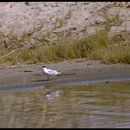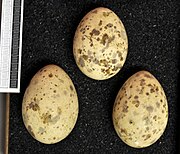en
names in breadcrumbs


Regular passage visitor and winter visitor.
A medium-sized (14 inches) tern, the Gull-billed Tern in summer is most easily identified by its pale wings, solid black cap, and thick black bill. In winter, this species loses most of its black cap, becoming light gray on the head with black eye-stripes. Male and female Gull-billed Terns are similar to one another in all seasons. The Gull-billed Tern inhabits every continent except Antarctica. In North America, this species breeds along the Atlantic coast of the U.S. south of New York, along the Gulf coast, and in southern California. Populations breeding in the Gulf are non-migratory, while those on the Atlantic and Pacific coasts winter in Florida, on the Gulf coast, and in the tropics as far south as Argentina. Gull-billed Terns primarily breed in dunes, on sandy barrier islands, or in coastal marshes. Similar habitats are utilized during the winter, although this species may also be found further inland in flooded fields at that time of year. Gull-billed Terns primarily eat small aquatic animals, including insects, small fish, and crustaceans. Gull-billed Terns may be observed flying above beaches and near-shore waters while catching prey. This species catches insects in the air, but does not dive into the water to catch fish (unlike many other terns), preferring to skim the surface or catch fish while standing in shallow water. Gull-billed Terns are primarily active during the day.
A medium-sized (14 inches) tern, the Gull-billed Tern in summer is most easily identified by its pale wings, solid black cap, and thick black bill. In winter, this species loses most of its black cap, becoming light gray on the head with black eye-stripes. Male and female Gull-billed Terns are similar to one another in all seasons. The Gull-billed Tern inhabits every continent except Antarctica. In North America, this species breeds along the Atlantic coast of the U.S. south of New York, along the Gulf coast, and in southern California. Populations breeding in the Gulf are non-migratory, while those on the Atlantic and Pacific coasts winter in Florida, on the Gulf coast, and in the tropics as far south as Argentina. Gull-billed Terns primarily breed in dunes, on sandy barrier islands, or in coastal marshes. Similar habitats are utilized during the winter, although this species may also be found further inland in flooded fields at that time of year. Gull-billed Terns primarily eat small aquatic animals, including insects, small fish, and crustaceans. Gull-billed Terns may be observed flying above beaches and near-shore waters while catching prey. This species catches insects in the air, but does not dive into the water to catch fish (unlike many other terns), preferring to skim the surface or catch fish while standing in shallow water. Gull-billed Terns are primarily active during the day.
The gull-billed tern (Gelochelidon nilotica), formerly Sterna nilotica, is a tern in the family Laridae. It is widely distributed and breeds in scattered localities in Europe, Asia, northwest Africa, and the Americas. The Australian gull-billed tern was previously considered a subspecies.
The gull-billed tern was formally described in 1789 by the German naturalist Johann Friedrich Gmelin in his revised and expanded edition of Carl Linnaeus's Systema Naturae. He placed it with terns in the genus Sterna and coined the binomial name Sterna nilotica.[2] Gmelin based his description on the "Egyptian tern" that had been described in 1785 by the English ornithologist John Latham in his book A General Synopsis of Birds.[3] Latham had in turn based his own account on that by the Swedish naturalist Fredrik Hasselquist that was published in 1757.[4] The gull-billed tern was moved to the resurrected genus Gelochelidon based on a molecular phylogenetic study published in 2005.[5][6][7] The genus had been introduced in 1830 by the German zoologist Alfred Brehm.[8] The genus name combines the Ancient Greek gelaō meaning "to laugh" with khelidōn meaning "swallow". The specific epithet nilotica is from Latin niloticus meaning "of the River Nile".[9]
Five subspecies are recognised:[7]

This is a fairly large and powerful tern, similar in size and general appearance to a Sandwich tern, but the short thick gull-like bill, broad wings, long legs and robust body are distinctive. The summer adult has grey upperparts, white underparts, a black cap, strong black bill and black legs. The call is a characteristic ker-wik. It is 33–42 cm (13–17 in) in length and 76–91 cm (30–36 in) in wingspan.[10][11] Body mass ranges from 150–292 g (5.3–10.3 oz).[12]
In winter, the cap is lost, and there is a dark patch through the eye like a Forster's tern or a Mediterranean gull. Juvenile gull-billed terns have a fainter mask, but otherwise look much like winter adults.
Juvenile Sandwich terns have a short bill, and are frequently mistaken for gull-billed tern where the latter species is uncommon, such as North Sea coasts.
It breeds in warmer parts of the world in southern Europe, temperate and eastern Asia, both coasts of North America, eastern South America. This bird has a number of geographical races, differing mainly in size and minor plumage details.
All forms show a post-breeding dispersal, but the northern breeders are most migratory, wintering south to Africa, the Caribbean and northern South America, southern Asia and New Zealand.
The gull-billed tern is one of the species to which the Agreement on the Conservation of African-Eurasian Migratory Waterbirds (AEWA) applies.
The gull-billed tern breeds in colonies on lakes, marshes and coasts (including bays and earthen levees). It nests in a ground scrape and lays two to five eggs. While widely distributed in freshwater areas in Eurasia, it is associated almost solely with saltwater, coastal areas in North America.[10]
This is a somewhat atypical tern, in appearance like a Sterna tern, but with feeding habits more like the Chlidonias marsh terns, black tern and white-winged tern. It does not normally plunge dive for fish like the other white terns, and has a broader diet than most other terns. It largely feeds on insects taken in flight, and also often hunts over wet fields and even in brushy areas, to take amphibians and small mammals.[10] It is also an opportunistic feeder, and has been observed to pick up and feed on dead dragonflies from the road.[13]
in Krishna Wildlife Sanctuary, Andhra Pradesh, India
The gull-billed tern (Gelochelidon nilotica), formerly Sterna nilotica, is a tern in the family Laridae. It is widely distributed and breeds in scattered localities in Europe, Asia, northwest Africa, and the Americas. The Australian gull-billed tern was previously considered a subspecies.